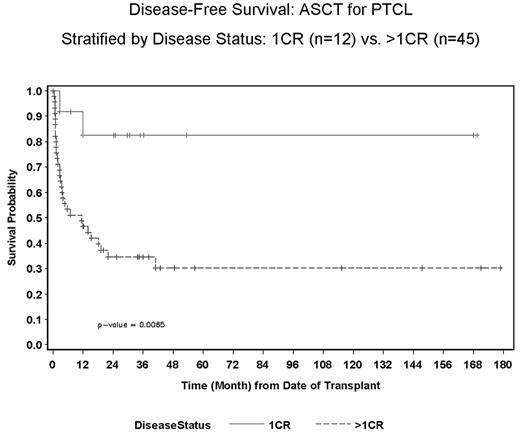Abstract
The majority of patients (pts) with PTCL present with advanced stage with high-intermediate or high-risk IPI and their prognosis are poor with current standard induction chemotherapy. HDT followed by ASCT has been shown to be effective therapy for relapsed and refractory PTCL, although the outcomes of transplant varied depending upon the histologic subtype, disease status and IPI at transplant. Given the poor outcome with current treatment approach, HDT and ASCT as consolidative therapy during first remission are being investigated in pts with PTCL. We performed retrospective analysis of all pts with T-cell, NK cell and null cell lymphomas who underwent HDT and ASCT between 2/1991 to 6/2005. We analyze the outcome based on disease status at transplant and the subset of PTCL. There were 57 pts (35 male, 22 female) with a median age of 45 years (range 5–68). Histology included 6 (10.5%) angioimmunoblastic T-cell lymphoma (AILD), 26(46%) Anaplastic large cell lymphoma (ALCL), 22 (39%) PTCL, unspecified (NOS), 1 panniculitis like T-cell, 1 NK-T, and 1 adult T-cell lymphoma. Twelve (21%) were transplanted during first remission; 11 were high intermediate-high risk IPI, and 1 for histology NK-T. Twenty-eight (49%) were transplanted during relapse or ≥second remission and 17 (30% ) induction failure or primary refractory disease. Twenty-one (37%) had advanced stage III-IV at transplant. The median number of chemotherapy regimens was 2 (range 1–5). For ALCL subtype, 9 were anaplastic lymphoma kinase (ALK) positive, 9 ALK negative, 8 unknown.
Results: At a median follow-up of 22 months (range 0.5–179), 29 are alive in remission, 25 relapsed and 3 died from transplant related mortality. One patient developed therapy induced myelodysplasia at two years post ASCT and is alive in remission after allogeneic stem cell transplant. The 2 years overall survival (OS) and disease-free survival (DFS) for the whole group were 53% (95% CI 46–60), and 45% (95% CI 39–50), respectively. The OS and DFS were significantly better for pts. who were transplanted in first complete remission (Figure1). The 2-year OS and DFS were both 83% (95% CI 55–94) for pts. transplanted in first remission compared to 45% (95% CI 38–52%, p=0.03) and 35% (95% CI 30–40, p= 0.006), respectively for those transplanted beyond first remission. Univariate models showed that the risk of death and/or relapse was significantly less among the pts. transplanted in first complete remission (OS, DFS and time to relapse: p < 0.05). When compared the outcome among the 3 subtypes, AILD, ALCL and PTCL NOS, there were no significant differences in survival or relapse among the 3 groups.
Conclusion: our results suggest that HDT and ASCT can improve prognosis and survival of pts. with PTCL. The outcome of ASCT is best when performed during first complete remission. The role of HDT and ASCT during first remission should be further investigated in larger multi-center studies. In contrast to other reports, the prognosis of pts. with ALCL is similar to other PTCLs.
Disease-Free Survival: ASCT for PTCL Startified by Disease Status: 1CR (n=12) vs. > 1CR (n=45)
Disease-Free Survival: ASCT for PTCL Startified by Disease Status: 1CR (n=12) vs. > 1CR (n=45)
Disclosure: No relevant conflicts of interest to declare.
Author notes
Corresponding author


This feature is available to Subscribers Only
Sign In or Create an Account Close Modal